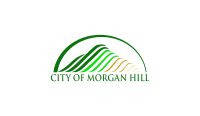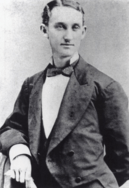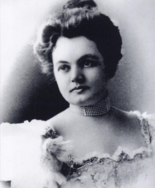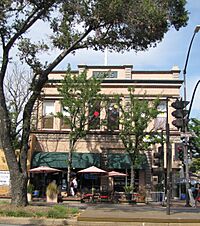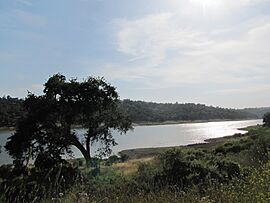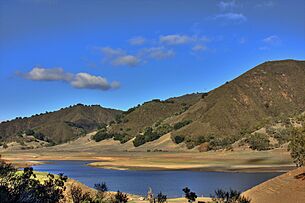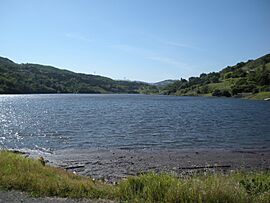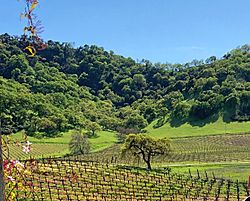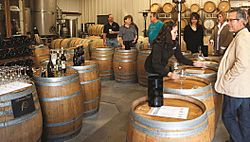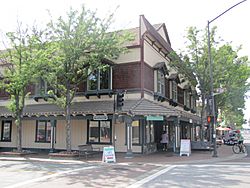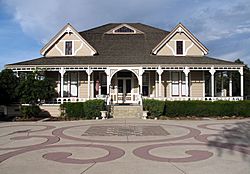Morgan Hill, California facts for kids
Quick facts for kids
Morgan Hill, California
|
||
|---|---|---|
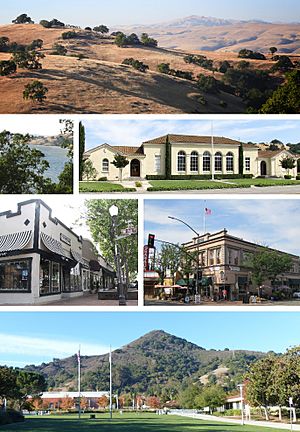
Clockwise: the Diablo Range hills, historic Morgan Hill Elementary Building, Votaw Building, Civic Center and El Toro, Downtown shops, Anderson Lake
|
||
|
||
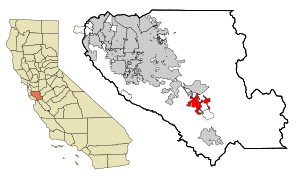 |
||
| Country | United States | |
| State | California | |
| County | Santa Clara | |
| Incorporated | November 10, 1906 | |
| Named for | Diana and Hiram Morgan Hill | |
| Government | ||
| • Type | Council–manager government | |
| Area | ||
| • Total | 12.94 sq mi (33.51 km2) | |
| • Land | 12.94 sq mi (33.51 km2) | |
| • Water | 0.00 sq mi (0.00 km2) | |
| Elevation | 350 ft (107 m) | |
| Population
(2020)
|
||
| • Total | 45,483 | |
| • Density | 3,514.9/sq mi (1,357.30/km2) | |
| Time zone | UTC-8 (Pacific) | |
| • Summer (DST) | UTC-7 (PDT) | |
| ZIP codes |
95037–95038
|
|
| Area code(s) | 408 and 669 | |
| FIPS code | 06-49278 | |
| GNIS feature ID | 1659174 | |
Morgan Hill is a city in Santa Clara County, California. It's located at the southern end of Silicon Valley in the San Francisco Bay Area. This city is a residential area, meaning many people live here. It's known for its connection to the high-tech industry, with several companies based here.
Morgan Hill is also a popular place for dining, entertainment, and outdoor fun. You can find wineries and many parks for activities like hiking and biking. The nearby Santa Cruz Mountains offer even more chances to explore nature.
Contents
History of Morgan Hill
Long before European settlers arrived, the Santa Clara Valley was home to the Tamien nation of Ohlone people. They lived here for over 6,000 years, gathering food and hunting.
In 1772, Spanish explorers Pedro Fages and Father Juan Crespí camped near what is now Morgan Hill. This spot later became a regular campsite for Spanish soldiers. When Mission Santa Clara de Asís was founded in 1777, the land became part of the Roman Catholic Church's property.
After Mexico gained independence from Spain, land was given to Mexican citizens. In 1835, Juan Maria Hernandez received the land where Morgan Hill now stands. Later, in 1845, Martin Murphy Sr. bought the area and named it Rancho Ojo del Agua de la Coche.

The Murphy family became very important in the area's history. By 1870, they owned about 70,000 acres around Morgan Hill. In the late 1850s, José María Malaguerra started growing grapes in Madrone, a town just north of Morgan Hill. In 1869, he opened the Malaguerra Winery, which is the oldest winery still standing in Santa Clara Valley. It's even listed on the National Register of Historic Places.
In 1882, Diana Murphy, a daughter of Daniel and Maria Murphy, married Hiram Morgan Hill. They built their weekend home, called Villa Mira Monte, in 1884. The name means "Mountain-View Estate" in Spanish.
In 1892, Hiram Morgan Hill hired a land developer to divide and sell most of his large ranch. He kept only the Villa Mira Monte estate and about 200 acres. By 1898, a community had grown around what people called "Morgan Hill's Ranch." A train station was built, and passengers would ask to stop at "Morgan Hill's Ranch," which soon became "Morgan Hill."
On November 10, 1906, Morgan Hill officially became a town. Hiram Morgan Hill passed away in 1913. His daughter, Diana Murphy Hill, later moved to the United Kingdom and sold Villa Mira Monte. This ended the Hill family's direct connection to the community named after them.
In 1959, Morgan Hill expanded by adding Madrone. This made Madrone Morgan Hill's northernmost area, close to San Jose.
Geography and Natural Features
Morgan Hill is about 24 miles (39 km) south of downtown San Jose. It sits in a valley, with the Santa Cruz Mountains to the west and the Diablo Range to the east. The city is about 350 feet (107 meters) above sea level.
The city covers about 12.9 square miles (33.5 square km) of land. While there are no natural lakes inside the city, there are several reservoirs in the nearby hills. These reservoirs help control floods and store water. They are also popular spots for outdoor activities like boating.
Morgan Hill is in the San Francisco Bay region, which means it's an area with earthquakes. The closest active faults are the San Andreas Fault, about 12 miles (19 km) southwest, and the Calaveras Fault, about 1 mile (1.6 km) northeast. Both of these faults have caused big earthquakes in the past. In 1984, Morgan Hill had an earthquake that measured 6.2 on the Richter scale.
Some of the lakes and reservoirs near Morgan Hill include Anderson Lake, Uvas Reservoir, Chesbro Reservoir, and Coyote Lake.
Morgan Hill is one of the few places where you can find a special type of gemstone called "Morgan Hill poppy jasper." This unique stone formed from volcanic and earthquake activity on the slopes of El Toro. You can see examples of poppy jasper at the El Toro Brewing Company, the Morgan Hill Museum, and the Morgan Hill Community and Cultural Center. The local Poppy Jasper Film Festival is also named after this stone.
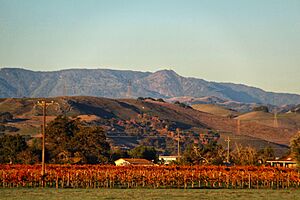
A key natural landmark is El Toro, a hill that overlooks the town to the west. A local story says that author Bret Harte named the hill after seeing two bulls fighting near its top. The official name is "El Toro," but locals sometimes call it "Murphy's Peak." El Toro is about 1,427 feet (435 meters) high and is even on the city's official seal and logo.
Neighborhoods of Morgan Hill
Morgan Hill has several neighborhoods, which can be divided into smaller communities. The main neighborhoods are:
- Downtown: This is the central area for entertainment and businesses.
- Madrone: A former town that is now Morgan Hill's northernmost area, bordering San Jose.
- Paradise Valley and Chesbro Lake
- Llagas Valley
- San Martin/South Morgan Hill: This includes the nearby area of San Martin.
- Coyote Valley/North Morgan Hill: This includes the nearby Coyote Valley area.
- Anderson Lake: This area includes residents near Henry W. Coe State Park.
Climate in Morgan Hill
Morgan Hill has a mild, Mediterranean climate, thanks to the nearby Pacific Ocean. Temperatures usually range from about 90°F (32°C) in midsummer to 34°F (1°C) in midwinter. The city gets about 18.9 inches (480 mm) of rain each year, and summers are typically dry. Snow is very rare in Morgan Hill. Summers often have coastal fogs, while winters have many sunny days with breaks between rainstorms. The area's landscape helps prevent tornadoes and severe thunderstorms.
| Climate data for Morgan Hill (1948 to 2016) | |||||||||||||
|---|---|---|---|---|---|---|---|---|---|---|---|---|---|
| Month | Jan | Feb | Mar | Apr | May | Jun | Jul | Aug | Sep | Oct | Nov | Dec | Year |
| Mean maximum °F (°C) | 61.3 (16.3) |
62.1 (16.7) |
62.8 (17.1) |
69.3 (20.7) |
75.4 (24.1) |
80.5 (26.9) |
86.4 (30.2) |
86.9 (30.5) |
85.2 (29.6) |
77.1 (25.1) |
63.6 (17.6) |
61.1 (16.2) |
72.6 (22.6) |
| Average precipitation inches (mm) | 4.83 (123) |
4.72 (120) |
3.21 (82) |
1.50 (38) |
0.29 (7.4) |
0 (0) |
0.03 (0.76) |
0 (0) |
0.04 (1.0) |
0.95 (24) |
2.39 (61) |
3.70 (94) |
21.68 (551) |
| Source: WRCC | |||||||||||||
Population and People
| Historical population | |||
|---|---|---|---|
| Census | Pop. | %± | |
| 1910 | 607 | — | |
| 1920 | 646 | 6.4% | |
| 1930 | 908 | 40.6% | |
| 1940 | 1,014 | 11.7% | |
| 1950 | 1,627 | 60.5% | |
| 1960 | 3,151 | 93.7% | |
| 1970 | 5,579 | 77.1% | |
| 1980 | 17,060 | 205.8% | |
| 1990 | 23,928 | 40.3% | |
| 2000 | 33,556 | 40.2% | |
| 2010 | 37,882 | 12.9% | |
| 2020 | 45,483 | 20.1% | |
| U.S. Decennial Census | |||
Population in 2020
In 2020, the United States census reported that Morgan Hill had 45,483 people living there. There were 14,721 households. The population was made up of different ethnic groups: 62.8% White, 1.5% African American, 0.5% Native American, 15.8% Asian, and 0.1% Pacific Islander. About 13.8% of the population identified as two or more races. People of Hispanic or Latino background made up 34.7% of the population.
Population in 2010
The 2010 U.S. Census showed that Morgan Hill had a population of 37,882 people. The population density was about 2,941 people per square mile. Most people (99%) lived in homes, while a small number lived in group housing or institutions.
The population included 28.6% under 18 years old, 7.7% aged 18 to 24, and 9.5% aged 65 or older. The average age in Morgan Hill was 36.8 years. For every 100 females, there were about 97.9 males.
Economy and Jobs
Forbes magazine has listed Morgan Hill as one of the most expensive places to live in the United States. This is partly because many wealthy people live here, and there are rules that limit new construction.
Morgan Hill is part of the Santa Clara Valley AVA. This is a special area known for its wineries and vineyards. It's a great place for wine tourism.
Many different types of companies are based in Morgan Hill. For example, Specialized Bicycle Components, a big company that makes high-performance bicycles, is located here.
The city has its own weekly newspaper, The Morgan Hill Times, which started in 1894. There's also a biweekly lifestyle magazine called Morgan Hill Life.
Technology Companies
Morgan Hill is home to several important high-tech companies. These include:
- Anritsu: A Japanese company that works with telecommunications.
- Flextronics: One of the world's largest electronics manufacturing companies.
- Velodyne: A company that develops sensors and lasers.
- Hypnos Entertainment: A video game company.
- Toray Advanced Composites: A Dutch company that makes advanced composite materials.
- Paramit Corporation: A company that makes high-tech medical devices.
Other tech companies, like Harris Corporation and Infineon Technologies, have research or manufacturing facilities in Morgan Hill.
Major Employers
Here are some of the biggest employers in Morgan Hill, based on a 2018 report:
| No. | Employer | No. of Employees |
|---|---|---|
| 1 | Morgan Hill Unified School District | 900 |
| 2 | Anritsu | 480 |
| 3 | Specialized Bicycle Components | 380 |
| 4 | Paramit Corporation | 300 |
| 5 | CalDoor | 300 |
| 6 | NxEdge | 280 |
| 7 | Lusamerica Foods | 270 |
| 8 | Mission Bell Manufacturing | 250 |
| 9 | Toray Advanced Composites | 250 |
| 10 | Infineon Technologies | 240 |
| 11 | Safeway | 230 |
| 12 | Velodyne | 200 |
Culture and Events
Morgan Hill hosts two main annual events:
- Mushroom Mardi Gras Festival: This festival started in 1980 to raise money for the fire department. It celebrates mushrooms because Morgan Hill was once known as the "Mushroom Capital of the World."
- Poppy Jasper International Film Festival (PJIFF): This film festival began in 2004 as a fundraiser for Morgan Hill's public-access TV channel. It shows films made by people from many different backgrounds.
Parks and Recreation

Morgan Hill offers many parks and recreational spots for outdoor activities:
- Anderson Lake County Park: Located just east of the city.
- Coyote Creek Parks & Trails: Extends north towards San Jose.
- Henry W. Coe State Park: The second-largest state park in California, great for hiking.
- Uvas Canyon County Park: A few miles west of Morgan Hill in the Santa Cruz Mountains.
- Galvan Park
- Morgan Hill Community Park: Includes a skate park and a dog park.
- Centennial Recreation Center: Has a gym, indoor pool, and centers for seniors and youth.
- Morgan Hill Community and Cultural Center: Features an amphitheater and a campus for Gavilan College.
- Morgan Hill Aquatic Center
- Morgan Hill Outdoor Sports Center
- Villa Mira Monte
Education in Morgan Hill

Public Schools
The Morgan Hill Unified School District (MHUSD) serves students in Morgan Hill, San Martin, California, and Coyote Valley. Many MHUSD schools have won awards like "California Distinguished School."
Morgan Hill's public high schools are:
- Live Oak High School
- Ann Sobrato High School: Ranked among the top 100 best public schools in California.
- Central High School (a continuation school)
The MHUSD also has special "focus academies" in partnership with The Tech Interactive. These academies let students specialize in subjects like engineering, STEAM (Science, Technology, Engineering, Arts, and Math), math, music, and health sciences. This allows for deeper learning in these areas.
Some of these academies include:
- Paradise Valley Engineering Academy
- P.A. Walsh STEAM Academy
- Jackson Academy of Math & Music
- El Toro Health Science Academy: The first elementary-level health sciences program in California, created with Stanford University.
- San Martin/Gwinn — Dual Immersion Multicultural Education: A program where students learn in both Spanish and English.
Morgan Hill also has a campus of Gavilan College, which offers college courses.
Private Schools
Morgan Hill has several private schools, both religious and non-religious.
Non-religious private schools:
- Oakwood School
- Stratford School
Religious private schools:
- Saint Catherine Catholic School
- Crossroads Christian School
- Spring Academy (an alternative Christian school)
- Shadow Mountain Baptist School
Transportation and Services
Airports
For small planes, there's the San Martin Airport (E16) about 4 miles (6 km) south of Morgan Hill. For bigger commercial flights, people use San Jose International Airport, which is about 24 miles (39 km) away in San Jose.
Public Transportation
- The Santa Clara Valley Transportation Authority (VTA) provides local and express bus services. You can take buses to nearby cities like Gilroy, San Martin, San Jose, Santa Clara, and Sunnyvale.
- Caltrain has a Morgan Hill station that offers train service during busy weekday hours. This connects Morgan Hill to San Jose, the rest of Silicon Valley, and San Francisco.
- Monterey–Salinas Transit runs an express bus (Line 55) during rush hour between San Jose and Monterey. This bus also connects to Amtrak Thruway services.
Public Libraries
The Santa Clara County Library District operates the Morgan Hill Library. It was renamed after former mayor Steve Tate.
Notable People
Many interesting people have connections to Morgan Hill, including those in arts, sciences, and sports.
Culture and Arts
- Kayla Cromer: A television actor.
- Mary Blair: A famous animator for The Walt Disney Company, known for films like Cinderella and Peter Pan.
- Dennis Johnson: A composer and mathematician.
- Kelly Moore: A New York Times Best Selling author.
Science and Innovation
- Konstantin Batygin: An astronomer at Caltech.
- Ole Fahlin: An aviator and developer for Lockheed Martin.
- Stephen C. Johnson: A computer scientist who worked at AT&T and Bell Labs.
Athletics and Sports
- Jared Allen: A football player who played for the Chicago Bears.
- Ricky Berry: A basketball player for the Sacramento Kings.
- Scott Clark: A BMX world champion.
- Harold Davis: A track and field athlete who held a World Record in the 100 meters.
- Mervyn Fernandez: A football player for the Oakland Raiders.
- Romina Gupta: A gold medal gymnastics champion for Team USA.
- Jarod Hatch: A swimmer who competed at the 2024 Summer Olympics.
- Daniel Holloway: A cyclist and multiple National Criterium champion.
- Zhang Jinjing: A Chinese Olympic gymnast.
- Marina Klimova: A Soviet Olympic ice dancer.
- Sergei Ponomarenko: A competitive ice dancer.
- Jeff Ulbrich: A football coach for the Atlanta Falcons and former player for the San Francisco 49ers.
Sister Cities
Morgan Hill has sister city relationships with several cities around the world:
 Mizuho, Tokyo, Japan
Mizuho, Tokyo, Japan San Martín de Hidalgo, Jalisco, Mexico
San Martín de Hidalgo, Jalisco, Mexico San Casciano in Val di Pesa, Tuscany, Italy
San Casciano in Val di Pesa, Tuscany, Italy Headford, County Galway, Ireland
Headford, County Galway, Ireland Seferihisar, Izmir, Turkey
Seferihisar, Izmir, Turkey
Images for kids
-
Upper Falls in Uvas Canyon County Park
-
Henry W. Coe State Park in eastern Morgan Hill
-
Coyote Lake in southern Morgan Hill
See also
 In Spanish: Morgan Hill para niños
In Spanish: Morgan Hill para niños


